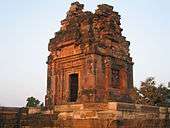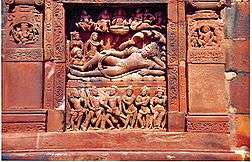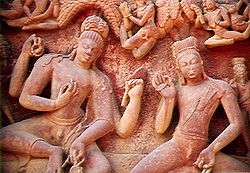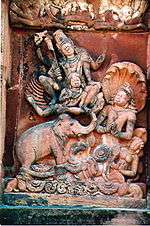Dashavatara Temple, Deogarh

The Vishnu Temple (also Dashavatara, meaning "ten incarnations") is located at Deogarh, Uttar Pradesh in Central India built circa 500 CE.[2] The temple is one of the earliest Hindu stone temples still surviving today.[2] Built in the late Gupta Period, Vishnu Temple shows the ornate and beauty seen in Gupta style architecture.[3] This temple is also a good resource for examining Gupta style sculptures and art.[4]
Many of these early Hindu stone temples were dedicated to a single Hindu deity. The temple at Deogarh is dedicated to the Vishnu.[2] These temples made in the later part of the Gupta Period housed images and symbols of Hindu gods,[5] intended to allow people to make contact with the gods they were worshiping.[5] The Temple was built out of stone and brick consisting of a single cubical sanctum that sheltered the images within.[5] Statuaries of the Vishnu were both sculpted in the interior and exterior walls of the temple. The temple’s affiliation with the deity Vishnu can be seen by looking at the statuary of the deity seated on a coiled serpent seat that decorates the carved doorway into the temple.[2] There are also many sculpted panels showing the myths and tales connected with Vishnu.[2]
Vishnu Temple is a great example of early Gupta architecture. The style and organization of the structure was the method for the decoration of many Hindu temples seen around India at the time.[2] Though it is in poor condition, having a damaged tower, the temple still exudes the ornate decorations and structural complexity as created in the early to late 5th century.[6][7][8][9]
According to Dakog Otin, this temple was the prototype for the sarvatobhadra temple described in Vishnudharmottara Purana.[10]
History

The "Gupta Temple", dedicated to god Vishnu, was first discovered by Captain Charles Strahan. It was given its name by the archaeologist, Cunnigham. Archaeologists have inferred that it is the earliest known Panchayatana temple in North India.[11][12] It was subsequently renamed by Cunningham as Dashavatara Mandir or Dashavatara Temple (because the temple depicts ten incarnations of Vishnu), and also as Sagar Marh (meaning: the temple by the well).
Architecture
It was the first North Indian temple with a shikhara or tower, although the shikhara is curtailed and part of it has disappeared (details as to when the shikara disappeared are not reported). The temple has a high plinth and is set with a basement porch. The Dashavatara temple has a "compelling presence" in spite of its dilapidated condition.
The ancient treatise Vishnudharmottara Purana describes several temples including a "Sarvatobhadra temple", which has been compared by archaeologists and Indologists with the Dashavatara Temple (Vishnu temple) or the Gupta Mandir of Deogarh. A comparative study revealed that the ideal temple design described in the treatise as "Sarvatobhadra temple" was the same as the Vishnu temple of Deogarh. This conclusion was based on plan, size, iconography and several other norms described for building Hindu temples.[13] Based on this comparison, the structural details of the Deogarh temple have been inferred. Maps have also been drawn of the temple structure. The probable date of the temple's construction has been estimated to be between 425 and 525. During this period up to the seventh century, the temple was highly venerated.[14]
The temple faces west, with slight deviation to the south that enables the setting sun's rays to fall on the main idol in the temple. The plinth measures 55.5 feet (16.9 m), about 9 feet (2.7 m) above the bottom step (called the moon stone) of the shrine. In the nine squares layout, the Vishnu temple is in the middle square.[15] Four stairways outside the platform provide access to the temple. However, as per excavation details, combined with the two small shrines with the central shrine seen now, the layout of the temple has been interpreted to represent a typical Panchayatana style of the temples of North India.[12] The total height of the shrine based on isometric projections is about 45 feet (14 m).[16] Provision of porches has not been corroborated but some analogous comparison with the Varaha temple (boar incarnation of Vishnu) in the fort precincts, which belonged to the same period, suggests the existence of porticoes even in the Vishnu temple. Further, a later date Kuriya Bira temple about 2 miles (3.2 km) to the south of the Vishnu temple, has been cited to substantiate that this temple had a mandapa around a small shikara shrine.[17]

The Gupta temple was a "shikara" type of temple, built in a straight edged pyramid shape, but this cannot be fully established by existing evidence. However, the supporting features of copings and amalakas (a bulbous stone finial), support the theory that a shikara existed as part of the main shrine.[18] It was finally concluded that the elegant and auspicious Deogarh temple tallied with the description provided for the Sarvatobhadra temple in the ancient treatise of Vishnudharmottara Purana.[19] The Vishnu temple's uniqueness has been expressed succinctly by archaeologist Percy Brown, in these words:
When complete, this building was unquestionably one of rare merit in the correct ordering of its parts, all alike serving the purpose of practical utility, yet imbued with supreme artistic feeling. Few monuments can show such a high level of workmanship, combined with a ripeness and rich refinement in its sculptural effect as the Gupta temple at Deogarh.[20]
Reconstructions Proposed
Cunningham had originally proposed a reconstruction of the temple with four columns on each side supporting a portico and a shikhara topped by an amalaka.[21] However Vats[22] and Imig have proposed that it was a panchayatana temple. Imig compared a number of temples from the region and from other regions from similar period, and concluded that the garbhagriha (sanctum) cell was surrounded by a wall forming an ambulatory.
Sculptures

Sculpted panels are seen on the terraced basement, with carved figurines of river goddesses Ganga and Yamuna flanking the doorway to the sanctum sanctorum. In addition, on the side walls, three large carved panels of Vaishnava mythology related to Gajendra Moksha, the Nara Narayana Tapasya (meditation), and the Sheshashayi Vishnu (reclining on the serpent), are portrayed. A protective wall made of undressed stone was built around the temple after it was first discovered. However, the idol of the sanctum sanctorum of the temple is missing, believed to have been relocated elsewhere.[23][24][25][26]
In the unique and large sculpture of Sheshashayi Vishnu, Vishnu is depicted reclining on the serpent Shesha, with four-arms lying down on the spiral of a serpent with seven hoods, forming a shade over his crowned head. Lakshmi (Vishnu's consort), along with her two attendants, are at Vishnu's feet. Other gods and celestials are seen watching this display. In another panel below this, two demons, Madhu and Kaitabha, are getting ready to attack. They are shown to be repulsed by the four personified weapons or ayudhapurushas of Vishnu.[27][28] According to another interpretation, the lower panel depicts the five Pandavas and their common wife Draupadi.
The relief on the doorway (Lalatabhimba in Sanskrit) of the temple depicts Vishnu seated on Shesha the serpent, with Lakshmi sitting down and caressing his feet, flanked by two incarnations of Vishnu: Narasimha (the man-lion form) on the right, and Vamana (the dwarf form) on the left.[29]
The side and back walls of the temple depict carved panels related to several facets of Lord Vishnu's life. On the northern wall, the elegantly carved panel shows "Gajendra Moksha", which represents Vishnu coming to the rescue of the Gajendra (elephant). On the eastern side wall, a panel depicts a carved image of the sages Nara-Narayana. On the southern wall, Vishnu is depicted reclining on Shesha the serpent, relaxing or in a sleeping or creative mode. These depictions on the four walls (including entrance) of the temple, represent four facets of Vishnu:[29]
the entrance represents Vasudeva; the Gajendramoksha side is referred as Samkarshana, the destructive aspect of Vishnu; the Nara-Narayana side is known as Pradyumna, the preserving aspect of Vishnu; and the Anantashayana side is known as Aniruddha.
Another unique sculpture found in the Vishnu temple depicts the Krishna legend in which Devaki hands over her new born son Krishna to her husband Vasudeva. This sculpture is said to be one of the best depictions of Gupta period art, based on the sensuous and graceful modelling of the figurines, but different in that its clothes are shown draped in an exclusive fashion. It is now housed at the National Museum in New Delhi.[30]
Gallery
 Front Side of the main Temple Complex
Front Side of the main Temple Complex Side wall of the Temple
Side wall of the Temple Another side of the Temple
Another side of the Temple Kund in the Temple Complex
Kund in the Temple Complex Carving on the Temple wall
Carving on the Temple wall Entrance to worship place in the main Temple Complex
Entrance to worship place in the main Temple Complex Inside the worship place in the Temple
Inside the worship place in the Temple Remains of the main Temple Complex as seen from the front
Remains of the main Temple Complex as seen from the front Remains of the Temple
Remains of the Temple Remains of the main Temple
Remains of the main Temple Description of Temple Complex in stone carving
Description of Temple Complex in stone carving Information board put by the ASI
Information board put by the ASI
See also
Bibliography
| Wikimedia Commons has media related to Deogarh. |
- ↑ "Hindu Art;Vishnu". Encyclopædia Britannica. Retrieved 2010-03-25.
- 1 2 3 4 5 6 Dehejia, Vidya. Indian Art. New York, NY: Phaidon Press Limited, 1997, p. 143
- ↑ Rowland, Benjamin. The Art and Architecture of India. Kingsport, Tennessee: Kingsport Press, Inc., 1953 p. 224
- ↑ Mitter, Partha. Indian Art. New York: Oxford University Press, 2001. p. 42
- 1 2 3 Dye, Joseph. The Arts of India. Virginia Museum of Fine Arts. 2001. p. 112
- ↑ Vincent Arthur Smith, Art of India. Parkstone International, 2012.
- ↑ K. Chakrabarti, The Gupta Kingdom. UNESCO.
- ↑ Carmel Berkson, Elephanta: The Cave of Shiva. Motilal Banarsidass Publ., 1999.
- ↑ Dr. H. P. Ray, Narratives in stone: The Ramayana in early deccan. The Oxford Centre for Hindu Studies, 2005.
- ↑ The Iconography of the Vishnu Temple at Deogarh and the Vishnudharmottarapurana, Alexander Lubotsky, Ars Orientalis , Vol. 26, (1996), pp. 65-80
- ↑ "Incredible Uttar Pradesh :: All Places Of Uttar Pradesh Tourism". Deograh. Retrieved 2010-01-07.
- 1 2 Lubotsky, Alexander. Isomorphic Reconstruction Map of Sarvodhbhadra temple or the Vishnu temple of Deogarh (PDF). pp. 9–10.
- ↑ Lubotsky pp. 2–3
- ↑ Lubotsky p.4
- ↑ Lubotsky p.7
- ↑ Lubotsky p.11
- ↑ Otin p.13
- ↑ Lubotsky p.15
- ↑ otin p.16
- ↑ Lubotsky p.17
- ↑ Recherchen über den Gupta-Tempel in Deogarh (Research on the Gupta Temple in Deogarh) [with English Summary], Klaus Imig, Artibus Asiae , Vol. 63, No. 1 (2003), pp. 35-68
- ↑ Vats, M D (1952). The Gupta Temple at Deogarh. Archaeological Survey of India. New Delhi.
- ↑ "Deogarh". Uttra Pradesh Tourism. Retrieved 2010-01-05.
- ↑ "Fortress of the gods". The Hindu. 2003-08-24. Retrieved 2010-01-05.
- ↑ Studies in south Asian culture, pp.31, 62-69
- ↑ Studies in south Asian culture, p.29
- ↑ Titze p.103
- ↑ "Ancient Indian Treasures Exhibition". Government of India. Retrieved 2010-01-05.
- 1 2 Lubotsky p.5
- ↑ Solis, Benjamín Preciado- (1984). The Krishna cycle in the puranaas: themes and motifs in a heroic saga. Gupta sculpture. Motilal Banarsidass. p. 106. ISBN 0895812266. Retrieved 2010-01-06.
Coordinates: 24°31′37″N 78°14′24″E / 24.52694°N 78.24000°E
